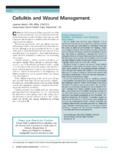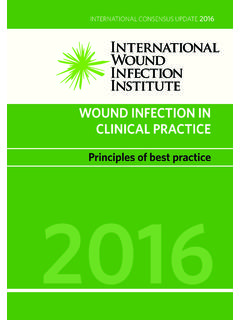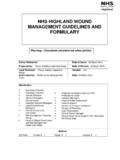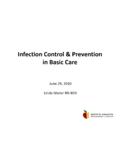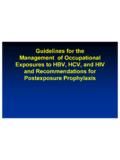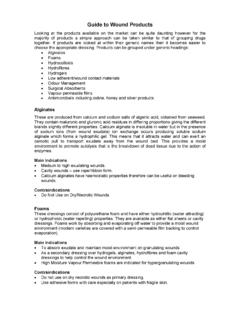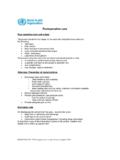Transcription of Identifying criteria for wound infection - cslr.cz
1 POSITIONDOCUMENTI dentifying criteria forwound infection Understanding wound infectionClinical identification of wound infection : a Delphi approachIdentifying criteria for pressure ulcer infectionIdentifying surgical site infection inwounds healing by primary intentionMANAGING EDITORS uzie CalneSENIOR EDITORIAL ADVISORC hristine MoffattProfessor and Co-director, Centre for Research and Implementation of Clinical Practice, Facultyof Health and Social Sciences, Thames Valley University, London, UKCONSULTANT EDITORSK eith CuttingPrincipal Lecturer, Buckinghamshire Chilterns University College, Chalfont St Giles, Bucks, andNurse Specialist, Ealing Hospital NHS Trust, London, UK Brian GilchristSenior Lecturer, Department of Nursing, The Florence Nightingale School of Nursing andMidwifery, King s College London, London UKFinn GottrupProfessor of Surgery, University of Southern Denmark.
2 The University Centre of wound Healing,Department of Plastic Surgery, Odense Hospital, DenmarkDavid LeaperEmeritus Professor of Surgery, University of Newcastle upon Tyne, UKPeter VowdenProfessor of wound Healing Research, University of Bradford, and Consultant Vascular Surgeon,Department of Vascular Surgery, Bradford Royal Infirmary, Bradford, UKEDITORIAL ADVISORS Dirk HollanderTrauma Surgeon, Department of Trauma Surgery, Bethanien Hospital, Frankfurt, GermanyMarco RomanelliConsultant Dermatologist, Department of Dermatology, University of Pisa, ItalyHiromi SanadaProfessor, Department of Gerontological Nursing, Division of Health Sciences and Nursing,Graduate School of Medicine, University of Tokyo, JapanJ Javier Soldevilla gredaProfessor of Geriatric Care, EUE University of La Rioja, Logro o, SpainLuc T ot Assistant Professor of Surgery, University Hospital, Montpellier, FranceDESIGNER Jane Walker PRINTED BYViking Print Services, UKFOREIGN EDITION TRANSLATIONSRWS Group, Medical Translation Division, London, UKEDITORIAL PROJECT MANAGERK athy DayPUBLISHING DIRECTORJane JonesPUBLISHED BY MEDICAL EDUCATION PARTNERSHIP LTD53 Hargrave Road, London N19 5SH, UKTel: +44(0)20 7561 5400 E-mail: wound MANAGEMENT ASSOCIATIONS ecretariat: PO BOX 864, London SE1 8TT, UKTel: +44 (0)20 7848 3496 MEDICAL EDUCATIONPARTNERSHIP LTD, 2005 All rights reserved.
3 No reproduction,copy or transmission of this publicationmay be made without writtenpermission. No paragraph of thispublication may be reproduced, copiedor transmitted save with writtenpermission or in accordance with theprovisions of the Copyright, Designs &Patents Act 1988 or under the terms ofany license permitting limited copyingissued by the Copyright LicensingAgency, 90 Tottenham Court Road,London W1P reference this document cite thefollowing: European wound ManagementAssociation (EWMA). PositionDocument: Identifying criteria for woundinfection. London: MEP Ltd, by an unrestrictededucational grant from:ConvaTec had no editorialcontrol over the content of thisdocument. The commentsand views expressed are thoseof the authors only and do notnecessarily reflect those criteria for wound infectionCJ Moffatt Professor and Co-director,Centre for Research andImplementation of ClinicalPractice, Faculty of Health andSocial Sciences, Thames ValleyUniversity, London, UK andImmediate Past President,European wound ManagementAssociation (EWMA).
4 Intense media interest and close public scrutiny have forced the subject of wound infectioninto the limelight. There is, in particular, interest in the rising prevalence of resistant bacterialstrains with their associated morbidity and mortality, and criticism of the indiscriminate useof antibiotics, which has been a crucial contributory factor in the rise of these resistantorganisms. There is also an increasing awareness of the cost burden of wound infection . It isclear that clinicians have a professional responsibility to promptly and accurately recogniseepisodes of infection and to treat them appropriately. This position document on Identifyingcriteria for wound infection is therefore both pertinent and treatment is to be effective, the complexity of the mechanisms involved and thepathophysiology of wound infection must not be underestimated.
5 Cooper, in the firstpaper of this document, stresses the need for a greater understanding of the complexinteractions that precede the development of overt wound infection and clearer definitionsof terms such as critical colonisation . infection is the end result of a complex interactionbetween the host, organism, wound environment and therapeutic interventions, which isfurther complicated by bacterial cooperation and virulence. Recognition of subtle clinicalchanges in the inflammatory response will be necessary if the early signs of infection are tobe to more precise and sophisticated clinical assessment tools will increase thepossibility for prompt diagnosis and help reduce patient morbidity. The second paper byCutting, White, Mahoney and Harding discusses recent work using the Delphi process toidentify clinical signs of wound infection in six different wound types.
6 In this study aninternational, multidisciplinary group of 54 wound care experts generated criteria forinfection in each wound type. A key consideration is the fact that, despite some commoncriteria, each wound type may present with different clinical signs of infection . These aresometimes of a subtle nature and will only be detected by consistent and repeatedobservation, but may provide vital clues to the early identification of two final papers in this document offer a detailed critical evaluation of the criteriagenerated by the Delphi study in two wound types: pressure ulcers and acute surgicalwounds. Both papers emphasise that to be clinically useful, each criterion identified in theDelphi study must be evaluated and validated with a clarification of the definitions used. Inthe absence of any other existing guidance, this work does raise significant issues andprovides a stimulus for further debate and the development of tools to help in the earlyidentification of importance of early diagnosis and treatment in patients with Grade 3 or 4 pressureulcers is emphasised by Sanada, Nakagami and Romanelli.
7 Recognising criteria ofinfection in these wounds is problematic because the signs of chronic inflammation are sosimilar to those for overt infection . The focus should be on close observation of the woundover time so that subtle changes can be the final paper, Melling, Hollander and Gottrup demonstrate how different thepicture is for Identifying infection in acute surgical wounds. A number of validated toolsexist for diagnosing and classifying surgical site infection . These are designedpredominantly for auditing, classification and surveillance. Early surgical discharge andreduced follow-up have implications for data collection and the recognition of the earlysigns of infection . The paper emphasises the need for the consistent application ofrecording tools if comparable data is to be all wounds will become infected and the level of suspicion will vary according tothe host status, susceptibility to infection and the consequences of any infection .
8 Thechallenge is to use the criteria generated by the Delphi expert panel as a platform forfurther work to provide clearer guidance for patients, carers and clinicians. The benefits areclear improved standards of patient care, faster intervention, reduced patient mortalityand lower financial costs to health services worldwide. INTRODUCTIONNORMAL IMMUNEFUNCTION OF SKINHost issuesPrincipal Lecturer in Microbiology,University of Wales Institute Cardiff(UWIC), Cardiff, Wales, wound infectionRA CooperInfection is the outcome of the dynamic interactions that take place between ahost, a potential pathogen and the environment. It occurs when host defencestrategies are successfully evaded by micro-organisms and results in deleteriouschanges in the host. Complex interactions that are not yet fully understoodprecede the development of an human body is not sterile.
9 Its outer surface, as well as canals and cavities that opento the exterior, provide a range of different environmental niches that become inhabitedby relatively stable but diverse, mixed communities of micro-organisms that constituteits normal flora. Total numbers of microbial cells are estimated to exceed human cells bya factor of at least ten, yet these commensals do not usually breach natural barriers unlessthe host becomes immuno-compromised or is wounded. Human host and micro-organisms normally exist in a balanced relationship. Indeed the normal flora can conferadvantages to its host in terms of protection from invasion by more aggressive species. When immuno-competent individuals are wounded an acute inflammatory responseis immediately initiated that leads to the ingress of blood proteins and phagocytic cellswhose function is to remove tissue debris and micro-organisms.
10 Arrival of thesecomponents causes the development of the cardinal signs of Celsus (redness, elevatedlocal temperature, swelling and pain). Coagulation of blood and the formation of afibrin clot help to establish an immediate plug to stem the movement of of microbial cells into the epidermis or dermis provides an opportunity forinfection, but rapidly mobilised immune responses help to limit this possibility. Until relatively recently the skin has been viewed simply as a passive barrier toinfection, but the presence of both innate and adaptive immune surveillance systems inskin indicates a more sophisticated role in protection against infection1. Within theepidermis and dermis reside sentinel cells such as keratinocytes, Langerhans cells, mastcells, dendritic cells and macrophages, which possess surface receptors capable ofrecognising antigens characteristically associated with pathogenic species.
